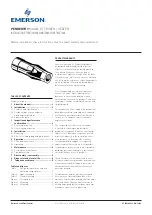
Real-Time Automation
47
ProMix 01 Getting Started Guide
•
When recalling a mix scene during a mix, try to choose a point
when the parameters to be changed aren’t being used. For exam-
ple, turn channels ON before the sound source starts, and turn
them OFF when it has finished. Also try to adjust fader levels
before a sound starts. Nothing sounds worse than abrupt level
changes halfway through a guitar solo, or the sudden disappear-
ance of a fading guitar solo due to premature muting. For mix
scenes that recall effects programs, try to recall them when no
sound is actually being processed by Effect1 or Effect2.
•
If you only want to change one effects parameter, instead of using
a mix scene, record the parameter change in real time as Control
Change data.
•
For effects, mix scenes store only the current program numbers
and parameter settings for Effect1 and Effect2. They do not store
all 40 available effects programs. Likewise for the dynamics pro-
cessors, only the current program numbers and parameter set-
tings of COMP1, COMP2, and COMP3 are stored. For EQ, all EQ
settings are stored, but the EQ library of 50 programs is not.
•
To ensure that only Program Changes are recorded, you could fil-
ter all other MIDI data types.
Real-Time Automation
To record and playback mix moves in real time you need to:
•
Set the CONTROL Tx and Rx parameters on the MIDI SETUP
LCD function to ON.
•
Set the MIDI Tx and Rx Channels. Note that this setting is affected
by the Control Change mode explained next.
•
Set the Control Change mode on the CONTROL CHANGE
ASSIGN LCD function to either Channel or Register. These modes
are explained in full in the User’s Guide. In Channel mode, Control
Changes are transmitted on several MIDI Channels. Con: with 96
parameters at most on each MIDI Channel, this will use at least
six MIDI Channels. Pro: If you assign these MIDI Channels to six
sequencer tracks, you have a better chance of being able to edit the
data since it’s spread across six tracks. You could reassign param-
eters so, for example, all ON/OFF Control Changes are in one
bank on one MIDI Channel, further simplifying data editing.
Some sequencers allow you to record data from several MIDI
Channels into one track. In this case, you could record the data
from all six MIDI Channels into any track.
In Register mode, all Control Changes are transmitted on the same
MIDI Channel and Control Change #98 (Non-Registered Param-
eter LSB) is used to specify the bank. Con: all Control Change data
is recorded to one track, so editing is more complicated. Pro: only
one MIDI Channel is used.



































